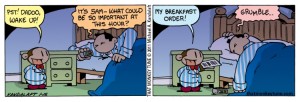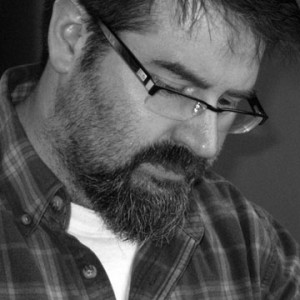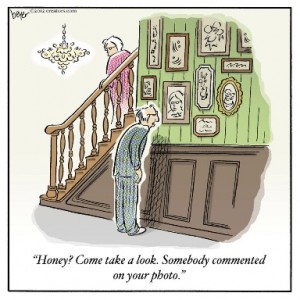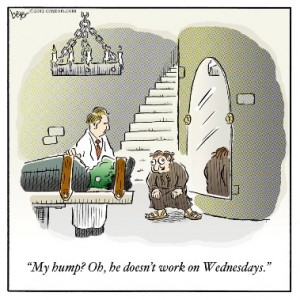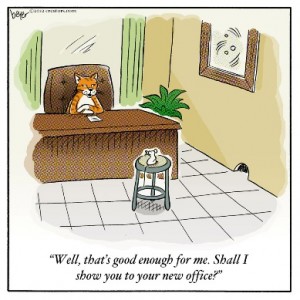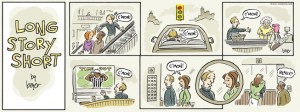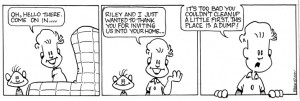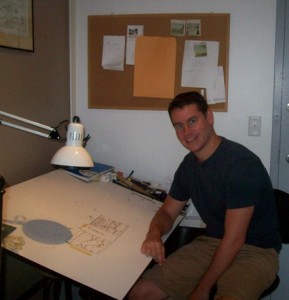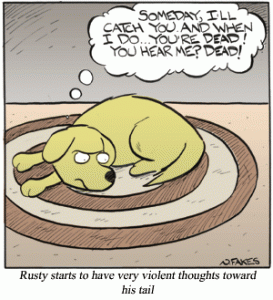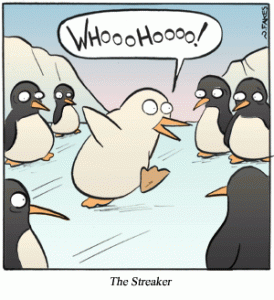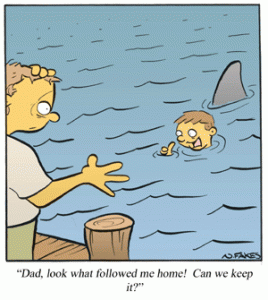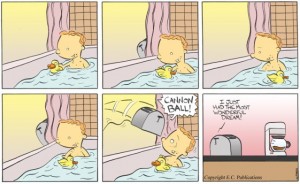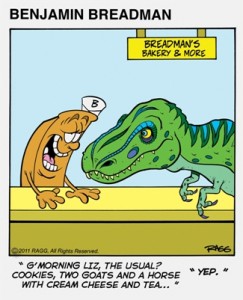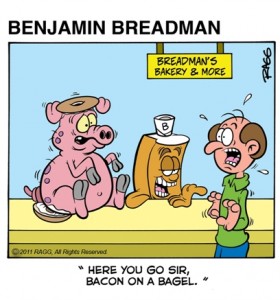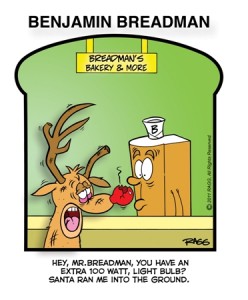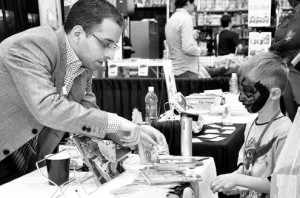
“That Monkey Tune” creator Michael Kandalaft speaks with a fan during the Chicago C2E2 ComiCon. Photo credit: Mackenzie McCluer
Michael Kandalaft is the creator of the comic “That Monkey Tune”, a fun and charming comic about monkeys living in the human world. Michael’s comic reaches over 150,000 readers in theU.S.andCanadaand the appeal of the characters and story is captivating. Last year Michael was admitted into The National Cartoonist Society, one of the highest honors, and he is represented by Ink Bottle Syndicate. When I talked with Michael I discovered that not only does he have a high work ethic but is one of the friendliest people you will meet. Now I would like to share with you a little of Michael Kandalaft and That Monkey Tune.
David: Hey Michael, it’s a pleasure to be featuring you and “That Monkey Tune”. You have such a great comic, when did you become interested in being a cartoonist and decide comics was the direction you wanted to take with your life? Who would be some of your hero’s in the comic’s world?
MK: Thank you for the compliment and for great opportunity to be interviewed.
I come from an artistic family, where my father is a painter, thus I have been drawing ever since I was a few years old. My father also grew up on “The Adventures of Tintin,” having actually bought the weekly installments when he himself was a child.
Since I could draw, I was always interested in comics specifically. The spirit, humor, and color appealed to me, as well as the immediacy and effectiveness of the medium to communicate visually. I don’t think I decided specifically to be a cartoonist until I was a few years older, maybe about ten years old, and I realized that I wanted to do something with my life that nobody could even tell me I couldn’t keep doing. I also wanted the ability to create something out of nothing, and develop my own unique voice from a myriad of experiences and influences.
I was also inspired to keep drawing by my first piano teacher, Mrs. Deanna Masi. Mrs. Masi would always include my cartoon drawings of monkeys playing piano in our recital brochures for all the other parents to see.
Mrs. Masi past away tragically after a stuggle with breast cancer when I was in high school, and anytime I find it hard to drag myself to the drawing board, I remember all the amazing people, like Mrs. Masi who have always supported my artwork and give it greater raison d’etre. I hope wherever she might be, she would be proud of my comics and how far I have come since I was a little kid doodling in between lessons.
As far as cartoonists, my original influences, besides Herge, the creator of “Tintin” which I referenced before, as well as Charles Schulz, Bill Watterson, Winsor McKay, and George Herriman. I also adore all the comics from the 30’s, like the original Frank King “Gasoline Alley” strips and George McManus “Bringing up Father.”
David: How did the idea and characters for “That Monkey Tune” come about?
MK: When I was born, I was given a stuffed monkey, which I named Johnny, after Johnny Carson, who still had a show when I was born. I never had any teddy bears, but by the time I was a few years old, had accumulated a number of stuffed monkeys, which have served as the inspiration for my comic strip characters.
David: How do you identify with the characters in “That Monkey Tune”?
MK: I believe my characters represent different parts of my personality, and hopefully others can relate as well in terms of their own traits and flaws. Elliot represents the emotional side, while Beagly represents the intellectual side. Dadoo and Umo (who are based on me and my brother), are a study in contrast between responsibility and irresponsibility. Elliot’s relationship with Zeus, his teddy bear, represents true love, and King Bubbles is a hopeless, insecure, and depressive character.
David: What are the things that inspire your comic and what’s it like for you in a daily “cartooning” routine?
MK: Inspiration comes from everyday life. Sometimes the ideas may come from events or recollections that happened years in the past, or they may come from the day before. I maintain a very strict cartooning routine, which included two parts – the writing, and the drawing. I always draw in batches, eight comics a week (six Dailies, one Sunday, and one bonus comic). Typically I will stagger the writing and the drawing, so I am always one week ahead with the writing, which I will then draw the following week. I typically start my day by writing each day at 6am for an hour, and end my day by writing for another hour. In between, I do my drawing, which I first sketch with pencil, then ink with an old fashioned calligraphy pen and ink bottle, then I erase and clean-up my comics, before I scan them in and color them on the computer.
David: What are the tools you use to create your comic and what are your favorites to work with?
MK: As I mentioned before, I draw with an old fashioned pen and ink. I have two nibs, one for lettering, and another for drawing. The ink is black India Ink. I use an HB pencil to do all my sketching before inking, and I use Strathmore Smooth Bristol board for all my work.
David: You have also become a member of “The National Cartoonist Society”, which is such a great honor. Can you give me a little insight into that?
MK: The NCS is an incredible society of the most talented and nicest cartoonists in the professional world. It is a great honor to be a member, and I always look forward to having a meeting of the cartoonist minds whenever possible.
David: What would you consider to be the greatest legacy you could leave with “That Monkey Tune”?
MK: The greatest legacy would be to add as much value as possible to as many people as possible throughout the world. To make one person smile is wonderful, but to make millions of people smile would truly be an incredible opportunity.
David: Thank you Michael. You have a bright future ahead. You have a fantastic comic and I can’t wait to see what you have in store for us.
Check out “That Monkey Tune” if you aren’t already familiar with Michael’s great comic.
You can also buy Michael Kandalaft’s new book “Ready, Set Go!”at www.amazon.com
www.facebook.com/thatmonkeytune

